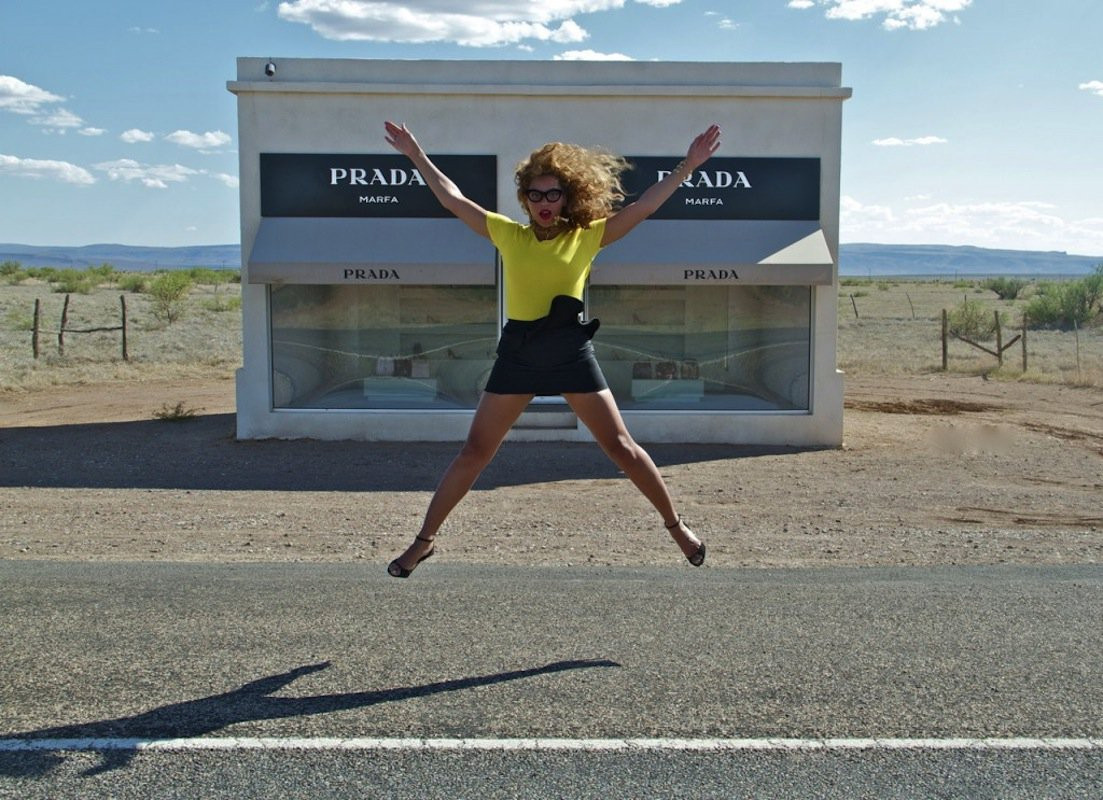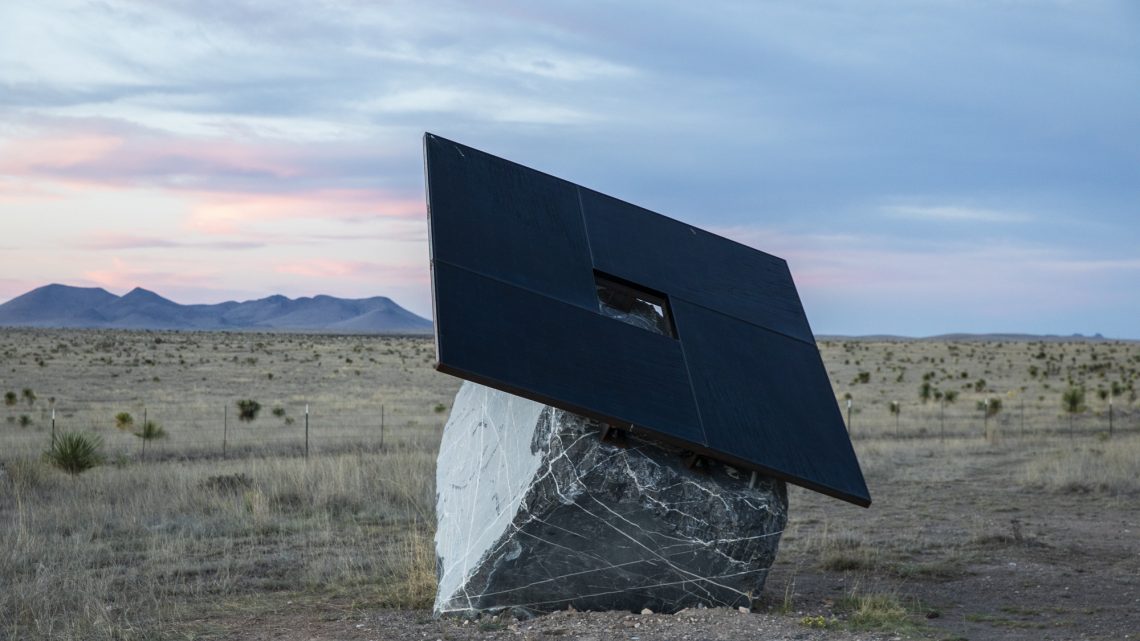
Marfa Is Magic
May 9, 2019As the sun sets on a Friday night in West Texas, a crowd is gathered in a field on the outskirts of Marfa, a town of fewer than 2,000 people. They stand between eight large, granite stones that are arranged in a circle near the dead-end of a road, with a ninth stone off to the side that has a large solar panel angled on top. Each stone is drilled with speaker holes and affixed with LED lights. As they begin to flash neon colors and bleat out a pulsing, metallic rhythm, the crowd draws into the center of the circle.
Half Stonehenge, half would-be Close Encounters desert dance party, this art installation is the work of British artist Haroon Mirza. Simply titled Stone Circle, it was commissioned by Ballroom Marfa, a local arts non-profit which on this same weekend is helping present Marfa Myths, an art, music, and film festival. The stones, powered by solar panel, are activated on each full moon, which happens to fall on the second night of the festival.
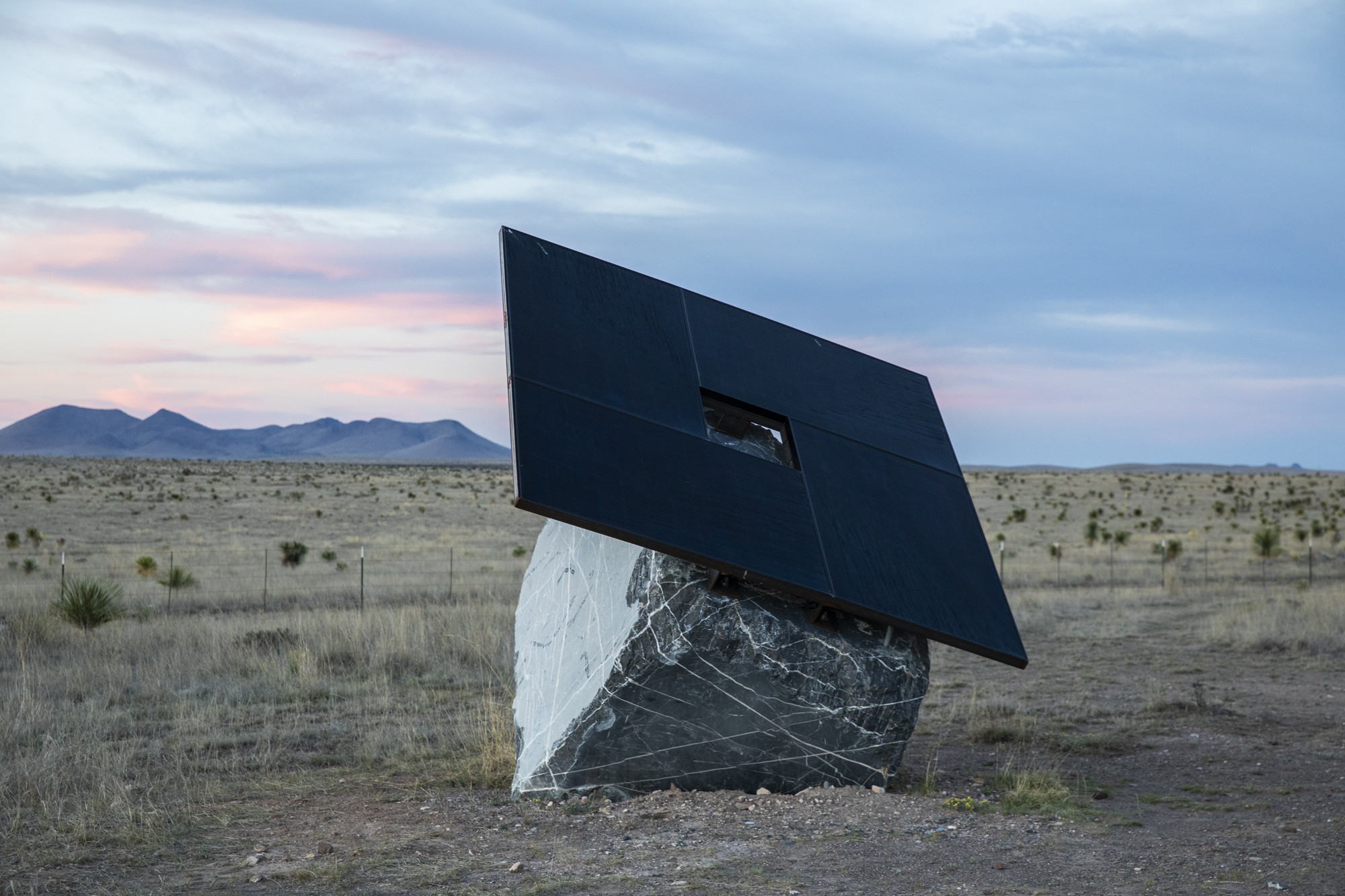
"I've been to stone circles in Scotland—they're of course from 3,000 years ago—and this is a pretty cool stone circle," said Austin Cooley, a radio DJ and musician who's lived in Houston since the early 1980s. He and his partner, Carol Sandin Cooley, first came to this desert outpost in 2007 to see Black Leather Jesus open for Sonic Youth. This is the couple's second time attending Marfa Myths.
Now in its sixth year, the late April festival is co-curated by Ballroom Marfa and Mexican Summer, a Brooklyn record label that brings in an array of different musical acts, ranging from indie artists like Deerhunter and Khruangbin to Jess Sah Bi & Peter One, an African folk duo from the Ivory Coast. Events are spread throughout the town, including at El Cosmico—a camping retreat that rents out teepees, yurts, or a brightly colored array of Airstream trailers — and the Chinati Foundation, an art museum where ambient and experimental sound composer Tim Hecker performs on the final day of the festival with the Konoyo Ensemble.
Drawing an estimated 800 attendees and relying solely on local vendors, Marfa Myths is decidedly small by festival standards. Yet that may be the only way it or the town can survive: Anything more might spoil this surreal artists’ enclave once and for all.

"Marfa Myths is very good. It's good for the town; it brings people in; it has a good lineup with a lot of diversity," Cooley said. "It very much reflects Marfa, which is not your typical West Texas town."
Located 60 miles from the Mexican border in the heart of the Chihuahuan Desert, Marfa was a typical West Texas town until the late 1970s, when New York artist Donald Judd relocated and began to build its buzz as a quirky, minimalist art haven. It was not exactly untouched by the wider world at that time, having been the filming location for James Dean's final movie, Giant, in 1955. Judd helped establish the Chinati Foundation on the site of a former military base in 1986, and by the turn of the millennium a new wave of inhabitants helped transform the town further still.
"When I grew up, there were seven feed stores and two art galleries. Now you got one feed store and about 50 art galleries," Fred Cobarrubias said. Though he now works for an oil company in nearby Fort Davis, Cobarrubias saw many of the changes firsthand. "It used to be a ranching town. Now it's an art town."
As Khruangbin bassist and Houston native Laura Lee recalled, Marfa's wider popularity has been fueled in part by its social media ubiquity. "About eight to 10 years ago, it started to become really popular for girls to take trips out [to Marfa] and stay at El Cosmico, just this beautifully Instagrammable destination where you can make people jealous with your teepee pictures," Lee said. Many others, including Beyoncé, make the trip to the even smaller town of Valentine a half-hour away, where there's a fake Prada storefront along the roadside. Yet none of that was enough to dampen Lee's first visit to Marfa. "I loved it so much," she said. "It lived up to what I imagined it would be like."
Though Judd died of lymphoma in 1994, his presence continues to loom large over the town, which maintains a sort of otherworldly, out-of-time mystique. There is only one flashing stop light on the main drag, a Dollar General store, and a host of other mom-and-pop businesses, but art lovers come in year-round from all over the world to see this special place for themselves.
"It's ironic that it's called Marfa Myths because there really is a mythical side to Marfa, which is the legend of Judd," Victoria Dreesmann said. Dressmann flew in from Sao Paulo, Brazil, to meet two of her friends, Maria Antonia Ferraz and Cecilia Tenure, and admitted she approached the trip with a degree of skepticism. "I assumed it would look fake or contrived or Disney-ish. Like, sure, it'll be nice, but it'll feel a bit like a circus that pops up on a Wednesday and leaves on a Friday. But it's really the opposite feeling."
Tenure, who is also from Brazil but came to Marfa from Los Angeles, said the sheer remoteness of the town adds to the authenticity of the experience. "It's a pilgrimage, no matter where you're coming from. It's a two-and-a-half-hour flight [from L.A.] and you still have a two-hour road trip," she said, referring to the drive she and her friends made from El Paso. Even larger cities in Texas, like Dallas, Austin, or Houston, are more than an eight-hour drive away. "Anyone who's here has gone through that and has that in common," Tenure said.
Art isn't the only thing that brings people to Marfa. The landscape itself is not only breathtaking, thanks to its endless expanses of sky, but also has its own natural mythology, with attractions like the Marfa Lights, a celestial phenomena first recorded in the late 19th century that was once featured on Unsolved Mysteries. (Marfa was also the punchline of a recent episode of The Simpsons.) Roughly an hour south is Big Bend, the only national park in Texas.
"It's incredibly quiet. You're always in nature and the artists who get brought here generally produce work that's inspired by the space," said Kathy McDaniel, who splits her time between Marfa and Dallas with her husband, Kevin Flynn. They first passed through town after McDaniel judged a chili cook-off in Terlingua, and they were among the crowd at Friday's stone activation ceremony.
Marfa Myths kicks off nearly six months of festivals in the area. Others include May’s CinemaMarfa film festival, June’s Agave Festival Marfa, and Trans-Pecos Music & Arts Festival, which takes its name from the surrounding region and is held solely on the El Cosmico grounds each September. Though smaller than an event like Trans-Pecos, Marfa Myths makes a point of integrating with the town. The leisurely pace of life in Marfa is even matched by the sequential scheduling of the festival, which only features a half-dozen or so events each day.
Not overwhelming the town does, indeed, require a delicate balance. "Face it, this is a small town where people live with very limited resources," said Emily Esperanza, who moved to Marfa last fall from California to be with her friends, Rie Oh and Jeffrey Mull, who relocated from Chicago. "The reality is, we don't have resources here, or infrastructure. People come here and expect to be able to party in the desert and have no real responsibility." Almost all the bars in Marfa close at midnight, and Oh points out that the town sometimes runs out of basic necessities like eggs and gasoline.
Over the winter, C3 Productions—the promoters behind large-scale mega festivals like Lollapalooza and Austin City Limits—announced plans to set up a new event in Marfa beginning in May 2020 that would bring in an estimated 5,000 people. Those plans were met with widespread backlash, and in the weeks leading up to Marfa Myths, C3 officially shelved the idea. Among the concerns was the likely strain on the town's water supply, not only for the sake of festival goers but for the land itself, which often has a high burn risk.
"It would destroy not only the town but the ecosystem," Oh said. Still, she sees the benefit of an event like Marfa Myths, as well as the larger predicament facing organizers. "It brings in people who are interested in meeting local people and engaging the arts. At the end of the day, tourism is the lifeblood of Marfa, whether you like it or not, but how we make it work [for the residents] is the hardest part about festivals sometimes."
Ty Mitchell, the owner of Lost Horse Saloon and one of Marfa's more unmistakable characters—a tall, slender, and imposing cowboy with an eye patch and a thick, bristly mustache—saw the C3 episode as a missed opportunity.
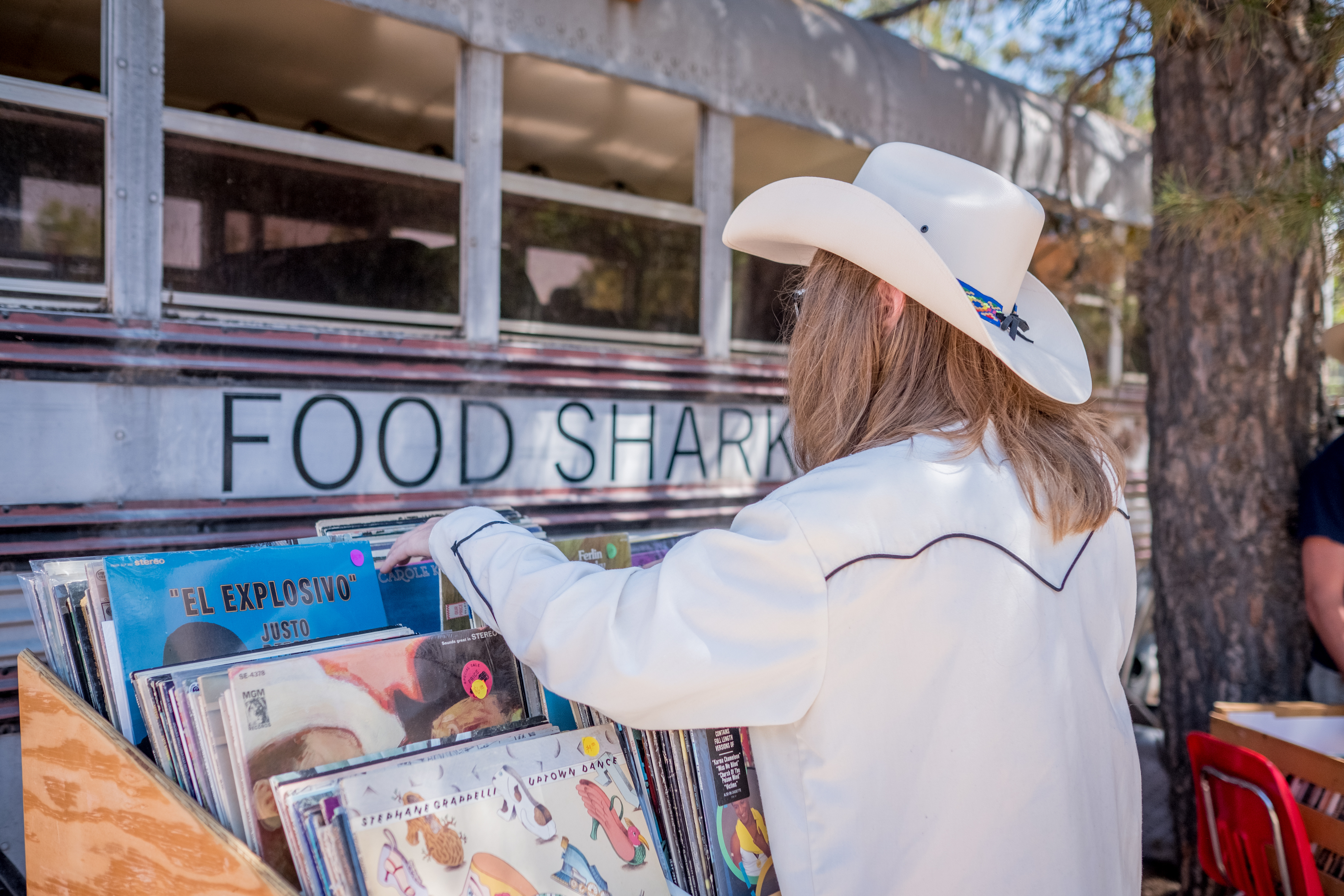
"Marfa got scared. Marfa is full of scared people. They just want their change. I would've respected them if they at least talked to [C3], but they didn't even bring 'em to the table," Mitchell said. He first came to town as a teenager, returning for good 15 years ago, and has a decidedly un-romanticized view of what he laughingly called a "hippie fight" between the different generations of local transplants. "This never was Mayberry, but it was Marfa. [And] it always will be Marfa, until they change the name," he said.
For all that, Mitchell is a fan of Marfa Myths; the Lost Horse even hosts a Saturday evening performance by eccentric showman Superstar & Star. "I love this festival. It's the right size, just the right crowd, and the music is very diverse," he said. Mitchell's only qualm is that there are no country artists on the bill, but he shrugged that off as well. "I get it. — it's not a country thing. I'm glad to see it and I welcome it."
Ballroom Marfa programming director Sarah Melendez said that organizers are well aware of not overtaxing the community. "I think the town naturally caps itself out with housing, food, and all those things. It's something we've been dancing with a bit, especially this year and last year as the festival has gotten more press and more attention," she said, estimating that the current turnout is already at the threshold of what could be considered sustainable.
The fans who flock in also seem cognizant of their role as invaders, and the potential impact they may have on the ecosystem. "People seem to be receptive. You walk down the street and everyone waves at you from their cars. I'm like, 'I don't belong here,' but they're making me feel accepted," said Ryan Burke, who came in with a group of friends from New York City.
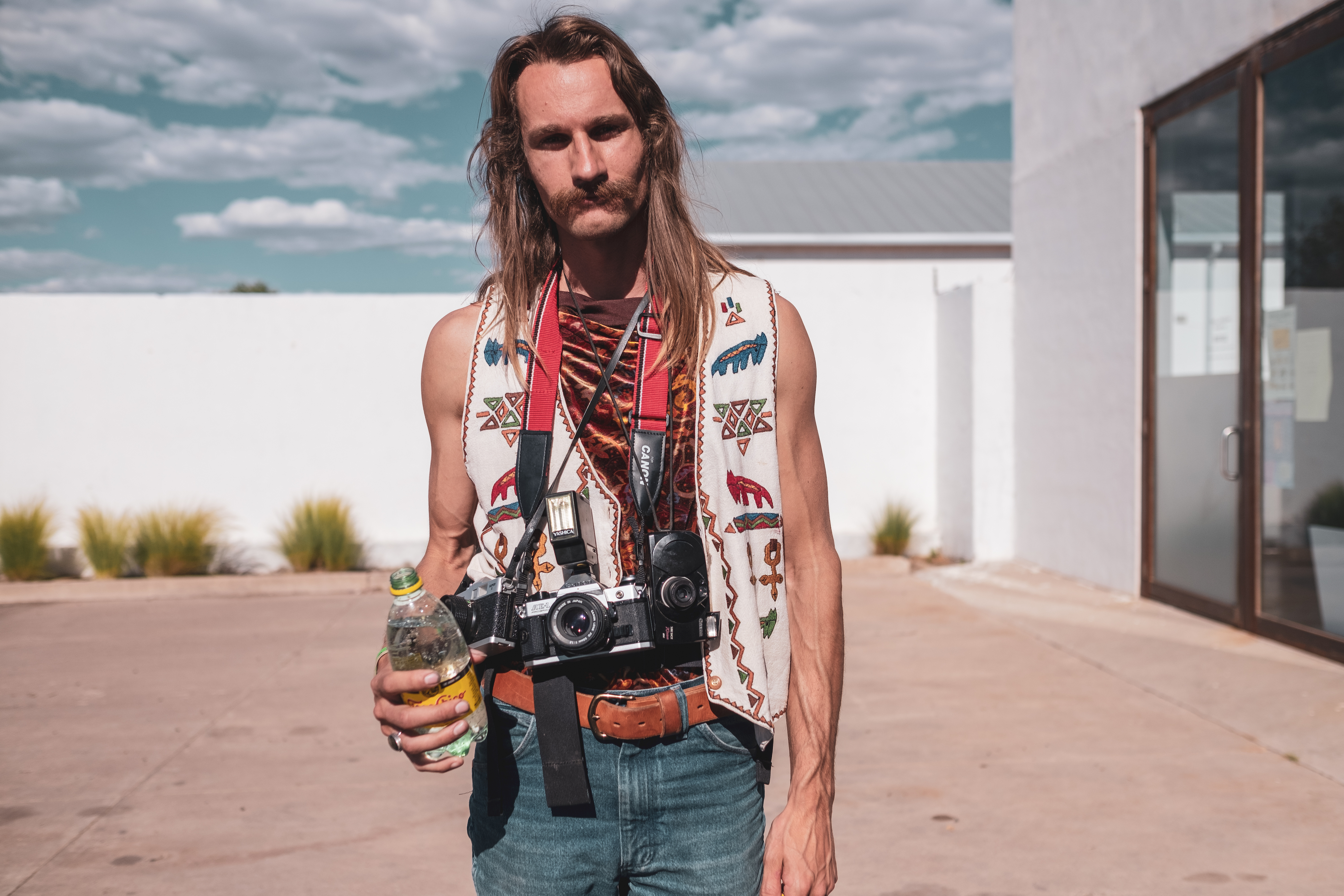
Seattle resident Julianne Peckov is making a return visit to Marfa Myths, camping with friends at El Cosmico. She struck a warier tone. "I was here in Marfa three years ago and the development here has gone way beyond," she said. "There's a lot of money coming in from everywhere, but the people who are here have already been disturbed, so you just deal with it. This whole town has a kind of weird, David Lynch-hipster vibe."
For now at least, Marfa's charm appears to be intact. Mimi Bowman has been coming to West Texas from Austin for over a decade, and this year hosts a bookstore pop-up at Marfa Book Co. "I feel like there's a lot more happening here of substance, culturally, than there is in Austin. Bowman said. "There's a transient quality to Marfa, in a way, where artists are drawn here to do a residency and then leave. It's more productive, creatively. They come here for a reason."
One such transient character is David Sleeper, who, like Mitchell, has come and gone from Marfa over the years. He first settled here in 1973 when a work project fell through, going on to stay for 25 years, and has returned briefly as an author in residence with the International Women’s Foundation while he works to complete a book. Sleeper appears all over town throughout Marfa Myths, riding a blue dirt bike from event to event with his dog, the mellifluously named Tejona Yolanda Garcia Lujan Rodriguez Armendariz de Montoya, perched on the back. The pair are even here for Friday night's ceremony, wandering around between the marble stones.
"I pay attention to serendipity. Something got me here, and it seemed like, 'I'm here, all my plans fell apart; there must be a reason I supposedly came.' So I just pay attention and go with the flow," Sleeper said, recalling his first spell in Marfa. "[Now] what I do is I jump on the motorcycle with the dog, ask if there's any serendipity, and go around and watch the smiles."

